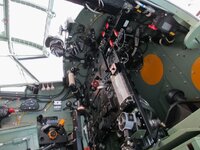MrSmoothie
Airman
- 68
- Jan 21, 2019
In doing research for the cockpit on an R/C model of the DH98 (FB VI) Mosquito I'm doing, I noticed prominent yellow dots -- on both crew and pilot seat backs, as well as lower starboard instrument area. Can anybody explain their purpose?






